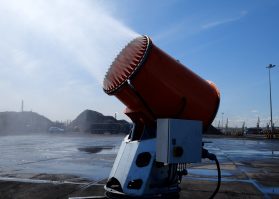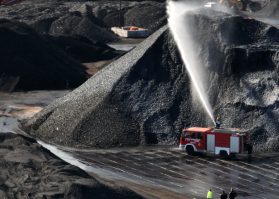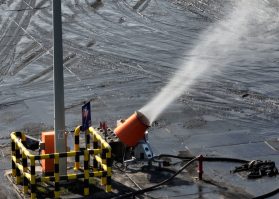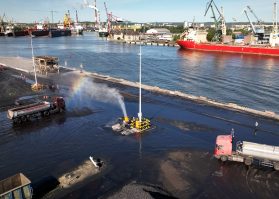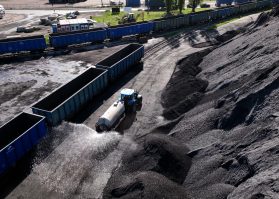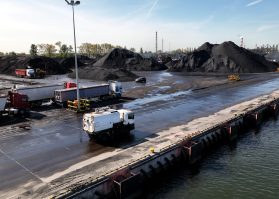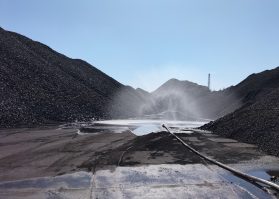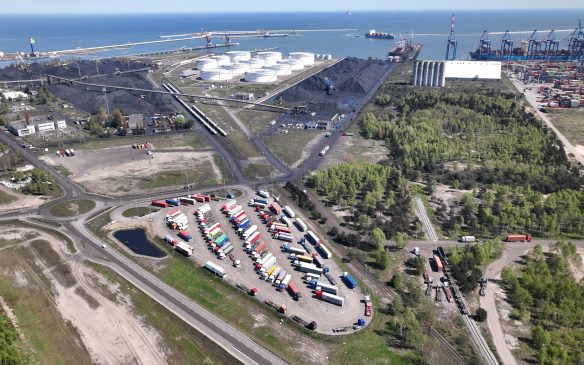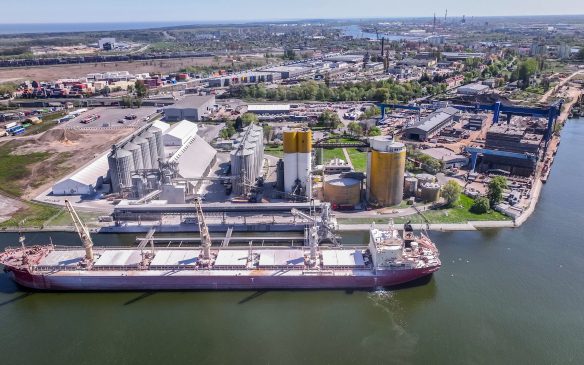New equipment at the Port of Gdańsk means less pollution
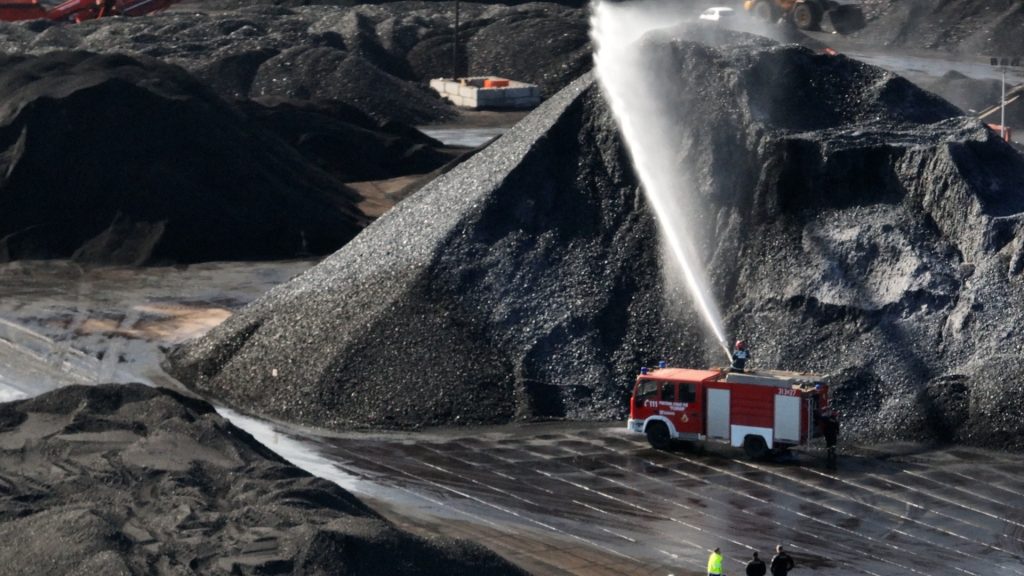
In order to reduce the amount of handling operations carried out, Port Gdański Eksploatacja has purchased new equipment that is much more efficient than any used previously. Some are already being used on the quays, along with the water curtains and cannons that generate a fog in order to reduce dust.
Two Liebherr LHM 550 mobile cranes will soon be delivered to Dworzec Drzewny Quay. The first in the second half of June 2023, the second towards the end of the year. The cranes are equipped with coal and ore grabs, along with a universal container spreader, allowing more coal to be handled in the same time and with fewer operations. Two new Liebherr LHM 280 mobile cranes will be delivered to the Szczecin quay in December of this year. They are to be equipped for handling bulk cargo, such as coal and grain, for handling coils (c-hooks) and have one universal container spreader. Agreements are in place for all these cranes while the payments are being made according to the schedule included in the Agreement.
“PG Eksploatacja has also purchased a closed-loop wash system for vehicle wheels and chassis, and its installation is nearing completion. It is fully mobile, and operates in a closed cycle, i.e. not one releasing any pollutants outside the facility, and in the coming days it will be used in the mining basin area in the part of the newly paved square between the F1 security post and the truck scales. It is mobile and has automatic scraper conveyors for removing contaminants,” said Łukasz Malinowski, President of the Management Board of the Port of Gdańsk.
PG Eksploatacja has also organised and purchased around 70 water curtains, along with cannons manufactured to produce water mist, used to spray water over the storage yards in the mining basin district. Similar solutions are also used by other operators. Furthermore, the cleaning of the yards is carried out wet, with the raw material collected being taken to the landfills provided for that purpose. The port also cooperates with firefighters, relying on their expertise. In the case of high winds, when the Harbour Master’s office halts work on the quays, the operators are also to stop the handling work, and are also not allowed to load coal onto trucks from a high height in order to reduce dust. Most coal is to leave the port area by rail, which uses conveyor belts and loaders to handle the raw material. The conveyor belts also have to be sprayed with water.
Cleaning the streets and preparing heaps
The Port of Gdańsk and all operators working here have to clean the traffic routes, such as roads, pavements, car parks and mooring paths, all located on properties owned by the Port of Gdańsk Authority. Furthermore, in accordance with the agreements concerning the manager of public roads, the port also cleans some of the roads belonging to the city. The current operation will be carried out until 15 July, and then continue if the need still arises. Currently, the streets being cleaned are Ku Ujściu, Trasa Sucharskiego, Przetoczna, the tunnel under Martwa Wisła and the beginning of Płażyńskiego Street. In total, this amounts to an area of over 287,000 sq m.
At the same time, coal handling companies carry out heap sprinkling in accordance with the weather conditions. In order to counteract dust, traffic routes and storage yards are cleaned and tidied, wetted with equipment dedicated for such work, and the products collected in this way are taken to landfill sites. A dust-reducing cellulose and polymer preparation is applied to the heaps and, in the case of heaps that begin to evaporate and smoke under the influence of the large quantities of water poured on them, they must be thickened in order to cut off the supply of oxygen to the smouldering fires. This can generate smoke and steam, which then ceases once such a heap has been stabilised. Thickening is carried out according to the technology implemented by the companies that deal with storing coal. If the raw material is stored for a longer period of time, it is laminated, which causes it to be surface-bound and significantly resistant to the effects of wind.
Coal and grain handling
In the area of the port of Gdańsk during the summer, operators continue to carry out coal handling, with as much intensity as the transport organised by recipients of this raw material in the country allows. This is dependent on the space available at the coal recipients’ yards. As we get closer to autumn, coal collection and handling also begin to take place for the next heating period.
“The raw material is not only used to meet the needs of households, but also for the cogeneration power plants in order to provide entire cities with heat and electricity. The logistics companies employed by the cogeneration power plants deliver the coal to its place of destination, following the guidelines on transport speed and covering the cargo with tarpaulins. The majority of the cargo, around 80% of it, leaves the port by rail,” said Kamil Tarczewski, Vice-President of the Management Board at the Port of Gdańsk.
In the case of road transport, if carriers do not follow the procedures, then the port has to cooperate with the police in order to enforce the rules regarding the movement of heavy cargo on public roads.
The companies handling coal at the Port of Gdańsk are: Port Gdański Eksploatacja, Przedsiębiorstwo Przeładunkowo-Składowe Port Północny, Rudoport, J&S Energy, Przedsiębiorstwo Przeładunkowo-Składowe Siark-Port, Speed, Węglobud and Weglokoks, Handel i Minerały Nowak and Polcopper. Since the start of increased coal handling at the Port of Gdańsk, the Port Management Board has engaged in a dialogue with the operators for the purpose of minimising the negative handling effects in the form of excessive dust. The port operators ensure that they are doing everything possible to reduce these effects on an ongoing basis. Port representatives also stay in contact with them on a daily basis, and continuously respond to the situation in the yards. Coal from the area leased by Siark-Port is to be removed by the end of May.
Less pollution, more car parks and sensors
In order to relieve the potential congestion caused by lorries, the Port of Gdańsk Authority has earmarked areas for the organisation of buffer positions for them. These buffer points are located on the following streets: Budowniczych Portu Płn. (150 parking places), Ku Ujściu (80 places), Załogowa (currently about 50 places, with a possible expansion up to 300) and Śnieżna-Handlowa (170 places). Buffer car parks are also planned at Kontenerowa (600 places) and Budowniczych Portu Płn. (150 places). It is also currently seeking permission from the City of Gdańsk for an additional parking area for vehicles in the vicinity of the port, due to a possible increase in the number of grain shipments from warehouses all over Poland for export by ship to the destination countries.
In addition, an app has been placed on the website www.portgdansk.pl, which allows you to view historical air quality data for all sensors located in the port area. It allows you to find out what the air quality is in a given place on a given day, but also how it has changed over the past few days. The four new graphs include the hourly averaged data for three days back and daily averaged data for seven days back. The air quality monitoring sensors, known as YetiBoxes, are deployed in seven locations: in the Free Customs Area, and at Szczecin quay, Oliwskie quay, Krakowskie quay, Zakręt Pięciu Gwizdków, on Marynarki Polskiej Street and in the Outer Port. Data charts are available at: https://bit.ly/3pQdSm9. Air quality data is also provided by Radio Gdańsk. The Port of Gdańsk is also planning to install another and even more sensitive sensor in a place to be indicated by the Nowy Port District Council.
The Port of Gdańsk Authority, together with representatives of the Nowy Port district, is working to obtain permission from the city land manager for new plantings in the Nowy Port area and is in talks with other districts to plant more trees there as well. Currently, the port wants to plant 4,000 trees, for which it needs formal approval from the city land manager. In Nowy Port, the planting project would take place along Oliwska Street.

